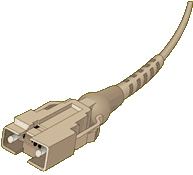Fibre Distributed Data Interface (FDDI)
Fibre Distributed Data Interface (FDDI) is a networking standard developed in the early 1980s by the American National Standards Institute (ANSI) for operating at speeds up to 100 Mbps. The standard FDDI network is set up in a ring topology with two rings that transmit signals in opposite directions to a series of nodes. FDDI accommodates up to 500 nodes per dual-ring network and allows up to 2 kilometers between adjacent nodes. FDDI uses the same token-passing scheme as the IEEE 802.5 Token Ring network to control transmission around the loop.
Redundancy
FDDI’s dual-ring scheme creates a redundant, fault-tolerant network that recovers data if the primary ring fails. In case the primary ring does fail, the second ring, a mirror of the first, picks up network communication instantly. Even though a network composed of two or more FDDI networks separates into its original rings after failure, only cross-network data is lost; internetwork data remains intact.
Great performance over Long Distance
Although some network architectures promise speeds much faster than FDDI—Gigabit Ethernet boasts a cool 1000 Mbps, for instance—FDDI is unmatched over the long haul. Depending on cable type, FDDI networks can stretch up to 100 km in circumference. And FDDI speed can be improved. If the second ring is used as its own network, both rings can operate individually at speeds as fast as 200 Mbps.
This feature is great for high bandwidth applications, though it lacks fault tolerance.
Data Signal Integrity
 Data signal integrity is another major advantage of FDDI networks. fibre optic signals are immune to EMI/RFI and suffer much less attenuation than their copper-borne counterparts. Additionally, fibre is extremely difficult to tap, so it’s a great choice for high-security networks and applications.
Data signal integrity is another major advantage of FDDI networks. fibre optic signals are immune to EMI/RFI and suffer much less attenuation than their copper-borne counterparts. Additionally, fibre is extremely difficult to tap, so it’s a great choice for high-security networks and applications.
Fibre cable: flexible, pliable, thin and light-weight
Although fibre cable can be tricky to terminate, especially when compared to copper, its physical properties make it a solid choice for installation. The cables themselves are extremely flexible and pliable. fibre cable is also very thin (3 mm on average) and weighs approximately one tenth as much as standard Ethernet cable.
Learn more:
Fibre Channel Technology.